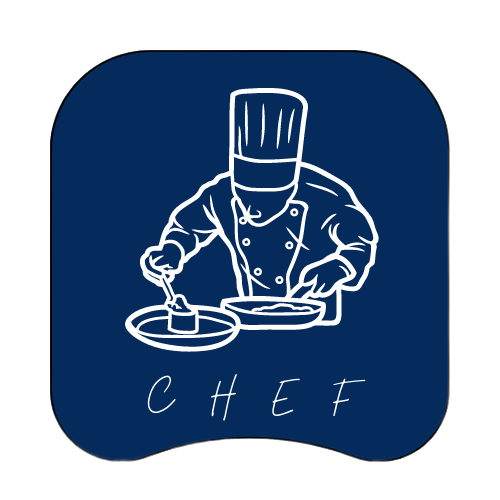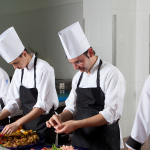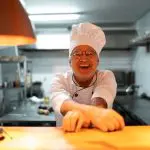A sous chef is the right-hand person to the head chef. As the head chef’s second in command the sous chef will have a great deal of responsibility within the kitchen. Including; managing staff, overseeing daily operations, sourcing ingredients, creating recipes and keeping the quality of food up to company standards. Additionally, the sous chef will be key in maintaining the kitchen hygiene standards and the health and safety requirements. Sous chef originates from the French language. A Sous-Chef de Cuisine translates to (under-chef of the kitchen). This is the next level up the kitchen brigade ladder from a chef de partie.
Want To Skip Ahead?
What Is A Sous Chef? A Definition Of The Job Description And The Meaning Of Sous Chef
Qualities of a Sous Chef
Almost always sous chefs attain their position by working their way up the ladder within a kitchen brigade.
And this has been done through training, experience, perseverance and hard work.
“They will be working their way up the ladder.”
There are three main levels of sous chef:
Junior sous chef
First of all, the junior sous chef is the assistant of the sous chef with similar responsibilities.
Sous Chef
The head chef’s second in command at this level the sous chef will have a great deal of responsibility within the kitchen.
Executive sous chef
This is a sous chef who will have a great deal of experience. Consequently, they will have proved themselves to be an excellent sous chef.
What Are The Key Qualities?
And now we understand what a sous chef is, and what are the key qualities. Key qualities that a sous chef will need to possess for example: the ability to quickly delegate jobs to a large staff team in an authoritative manner.
And they will also need to use a great deal of experience they have gained whilst working at each different level within a kitchen brigade. So being able to successfully teach and mentor junior members of staff.
In addition, they may have responsibilities outside of the kitchen. These may include the scheduling of staff rotas and other administrative jobs.
Furthermore, it is possible for a quarter of a sous chef’s time to be taken up by doing paperwork.
A Job Description, Their Responsibilities And Duties.
The most common establishments where they will be employed will be a restaurant and hotels followed by cruise ships. Due to the culinary position of a sous chef, there comes a lot of responsibilities and duties. Also, they will be reporting directly to the executive chef.
Chefs who are successful in this position will quickly learn an in-depth familiarity with kitchen operations. Therefore they can fill in for the executive chef when needed and assist them in resolving any problems that may occur on the job.
And will be responsible for how the food is presented on the plate. Another job will include the planning of the presentation and directing others to do so.
Also, they will be keeping their kitchen staff organised, training any new chefs, and planning and creating the work schedules for the team to follow.
And also essentially making sure all the food goes out to the customers at the best level of quality possible to keep the customers happy.
Sous Chef’s will also be responsible for any other duties laid out in the job description
Most of all they will have the responsibility for the food preparation within the kitchen. This may include the planning and directing of tasks to staff.
And they will also need to supervise team members and keep an eye out for problems that may arise and take control of the situation in an instant.
Other responsibilities may include; the need to discipline underperforming staff. And this will need to be done in an effective way. They will need to drive the team to meet and go beyond expectations by encouraging chefs within their roles.
What Do They Do?
Junior
Assisting the sous chef in their job role and taking on the same responsibilities.
Sous Chef
Most of all they are second in command of the kitchen, being the head chef’s right-hand person.
Executive
This is a position mainly in large establishments overseeing the sous chefs, and as a result, there may be a lot of paperwork within this role.
What Is The Average UK Salary?
What is a sous chef’s salary? This position is one of the higher-level jobs within an establishment, as a result, the salary reflects this.
In addition, they may have additional compensation such as bonuses or other benefits.
As with most kitchen positions, salaries depend greatly on the establishment. Due to the location and the previous experience of the chef.
Below is an average sous chef salary in the UK:
Junior £21000 – £27000 Average salary = £23000
Sous £23000 – £29000 Average salary = £25000
Executive £25000 – £31000 Average salary = £27000
A Mise en Place Definition And Why Do Sous Chefs Use These Lists?
To begin with, a mise en place definition: firstly this phrase comes from the French meaning – ”putting in place”, this refers to the set-up of a section by a chef ready to serve food.
Many professional kitchens use the culinary French phrase mise en place to refer to the organisation of a section by a chef.
This will be all of the preparation needed to set a section up for a shift. Furthermore, a mise en place list is important to help chefs organise themselves when working on a section.
And these lists can be used to help home cooks organise themselves well.
Mise en place Lists Are An Important Task That Helps A Chef To Be Organised.
Tips For A mise en place List
For example, a sections mise en place must be prepared and ready to go for service. Additionally, a variety of tasks need to be completed for every section of the kitchen.
The first job to complete is to write a full list of all the jobs that need to be completed for the section.
In many places, the menu will run for a set period of time. So a full list of all ingredients needed and preparation work to be done can be made and kept on the section.
The chef will then need to go through the list and tick each job that will need to be completed for that specific day. This will be all the tasks that are needed to be completed.
And from here the jobs can be organised so that the tasks which take the longest time to complete can be worked on first.
Why Is It Important To Be Organised In A Kitchen
The organisation is essential in a professional kitchen. With this in mind, it’s important that every chef is organised, and working towards further organisational improvement.
Whether you are a commis chef organising yourself to complete basic jobs (peeling potatoes or putting stock away correctly). Or maybe a chef de partie organising his section for a busy service; it’s essential that you get this right. Consequently, a well organised section contributes to a seamless kitchen operation. Furthermore, by staying focused and efficient, the entire team can work together effectively to deliver exceptional results.
What Are Organisational Skills For Sous Chefs?
Organisational skills, in essence, refer to the ability to manage time, energy, and resources effectively. Moreover, these skills are essential for achieving the tasks that you have been set to do. In addition,Self-discipline is also an effective ingredient in maximising your organisational skills.
As a result, these skills will help you to plan your work and implement the procedures needed to achieve your goals.
Consequently, a sous chef with good organisational skills is a great asset for any professional kitchen. Due to the fact they will work systematically to achieve the planned results.
Being organised will mean that you are more productive, give a positive impression to the kitchen management. And being able to work well with the restaurant team including the chef de rang.
Being Efficient In The Sous Chef Job Role
Being organised will also help you to keep your stress levels down. For example, you might lose time searching for a piece of equipment, or looking for a recipe on a piece of paper.
In addition, this will leave you in the lurch, and detract from other more important tasks. Organisation = efficiency.
It means that you are on the ball, and can complete each task within the allocated timeframe, before moving on to the next one.
Create Good Impressions
Organise yourself to earn your colleagues’ respect and represent your company well by meeting agreed timeframes. Working clean and tidy will also help you to create a positive impression of yourself.
Consider this:
- The general manager walks past your section and it’s a complete mess.
- The head chef walks past your section and it’s well organised, clean and tidy.
How Will Their Opinions Differ When They See You Working?
The 2nd option
Shows a level of responsibility, and that you are serious about your job and the company. It also shows that you are capable of larger jobs.
When a promotion becomes available, you stand a better chance of gaining it if you are efficient, organised and prepared.
The UK As A Sous Chef Career Choice
Starting your career at the bottom of a kitchen or after attending a culinary course makes the UK hospitality industry an excellent career choice.
Moreover, if you’ve begun your career in another country and want to travel and learn, the UK offers incredible opportunities to gain experience in a wide range of establishments.
Over time, you can progress from an entry level position to achieve your goal of becoming a skilled sous chef. In fact, today’s hospitality industry provides more choices and opportunities than ever before, making it the ideal time to pursue your goals.
Frequently Asked Questions For The Sous Chef Role
What are the main duties of a sous chef?
The managing of kitchen operations as an assistant to the head chef. For example; managing stock, food preparation, supervising staff, maintaining cleanliness and ensuring food quality.
Key essential skills of a sous chef
Key skills include; leadership and team management, time management and organisation, strong culinary skills, knowledge of food safety and hygiene, attention to detail and the ability to work under pressure.
What qualifications or experience are required to become a sous chef?
- Hands on experience in various cooking techniques and cuisines.
- Extensive kitchen experience, often starting as a commis chef and advancing.
- A culinary degree or certification is often preferred.
How does the sous chef role differ from the head chef?
The sous chef is the head chefs support (second in command). The head chefs focus will be on menu planning and the overall strategy of the kitchen. The sous chef looks after the daily operations, supervising staff and solving problems.
A typical day in the life of a sous chef
- Making sure health and safety regulations are followed
- Handling stock and ordering supplies
- Ensuring food quality and presentation
- preparing ingredients and overseeing meal preparation
- Managing kitchen staff rotas and assignments
Common challenges a sous chef will face
- Balancing creativity and consistency in food preparation
- Working long, irregular hours in high pressure work places
- Managing a diverse kitchen team
- Addressing unexpected issues, for example; equipment failure or staff shortages
What career progression options exist for sous chefs?
- Specialising in specific cuisines or culinary techniques
- Going for roles in teaching or consulting in the culinary scene
- Moving up to head chef, executive chef or chef de cuisine
- Transitioning to restaurant management or ownership
Average salary expectations for a sous chef
The salary depends on location and establishment. Try these websites for up to date salary expectations.
(caterer.com)
(totaljobs.com)
(talent.com)
What are the working conditions like for a sous chef?
- Sous Chefs often work long shifts, including evenings, weekends and holidays
- The job will include standing for long hours, lifting heavy objects, and working in a fast paced hot environment
How important is teamwork for a sous chef?
Teamwork is crucial. A sous chef must coordinate effectively with the kitchen staff, front of house staff, and the suppliers to keep the operation running smoothly. Additionally, ensuring a positive working environment.



















